Installing a gas dryer in a new addition. Dryer is on exterior wall so will use a direct vent.
exterior wall is spray foam insulation and already dry walled and sided.
The question is….after I cut my holes and run the vent I’m sure there will be air infiltration around the existing foam. Would you spray foam around the vent or leave some stand off and seal a plate to the interior dry wall.
i know the IRC does not require a dryer vent to be spaced from insulation.
but, to tight foam it in? Wonder since the vent will only be 10″ long if will be hotter due to close proximity to the dryer drum.
thanks



















Replies
Seal it somehow, from the outside. Caulk under the lip of the exhaust port, eg.
In fact, it may be wise to apply caulk to the side of the duct as you insert it from the outside, so that there is some degree of sealing between the duct and the exterior sheathing (under the siding).
And foam from the inside, if there is any sort of gap. In cold weather moisture is apt to infiltrate from the inside and condense on the duct surface, plus there is always somehow some air leakage from the outside in.
You're going to flash the outside and seal it to be weather tight. that alone will keep the air out but I'd run a bead of latex around the inside to keep bugs at bay.
Flashing/sealing the outside alone won't keep the air out, on metal or plastic siding. The seal needs to be to the sheathing.
As usual you're spouting off about something you have no understanding or knowlwdge of. Flashing goes under the siding so it will seal just fine.
How about putting your credentials at the bottom of your post like I do so posters can make a judgement about the value of the stuff you post?
My credentials are living in Minnesota rather than Florida. When that north wind blows it WILL blow through the joints in the siding and flood the space between siding and sheathing with cold air. If there is not a good seal between the duct and the sheathing, cold air WILL blow through the opening and into the house.
There are several different ways to seal between the duct and sheathing, but some sort of sealing is required (except perhaps in Florida).
It's almost like you don't understand flashing at all. Location doesn't matter, flashing in MN is exactly like flashing in Florida. Ever seen anyone flash a roof vent on top of shingles? I'll wait while you Google your answer. Flashing siding is just like flashing shingles, flashing under, siding over. It keeps rain and water out.
Where you live is not a credential, everyone lives somewhere. Get your construction experience down there so people can make a judgement as to the value of your answers.
Flashing may keep rain out, but it doesn't, by itself, keep wind out.
You've apparently never been in a poorly-sealed house when it's 10 below outside and the wind is howling out of the northwest at 20mph.
Of course flashing keeps wind out. How could it keep water out but not wind? Does window flashing keep wind out because it's the same as flashing a wall vent. Since I'm a professional contractor I've been in hundreds of poorly flashed houses but that's not what we're talking about here is it? Minnesota gets about half the annual rainfall we do and we get hurricanes to boot, we do our flashings correctly.
A wall of metal or plastic siding is only slightly less porous than a window screen. Wind blows right through it. And wind blows up under flashing.
How does wind blow under sealed flashing? You don't even understand that flashing is sealed! Give it a rest.
Sealed to what????
View Image
exterior wall is spray foam insulation and already dry walled and sided.
So how do you do your taping with the siding already installed?
Got no more time to waste on you.
That's odd -- you wasted a lot of time already, time that might have been better spent reading the OP's question.
Dryer vent
So after sealing nobody has a problem with spray foaming tight to the single wall vent
Are you worried about igniting adjacent materials? The vent doesn't get that hot.
There might be some spray foams which do not handle heat well and will deteriorate in contact with the duct, but such foams would not be very good in, say, a roof assembly, where temps of 150F might be seen. I wouldn't expect the duct temp to exceed 125F or so.
No, no problem at all but if you've cut a nice hole you won't be able to get much if any foam in there.